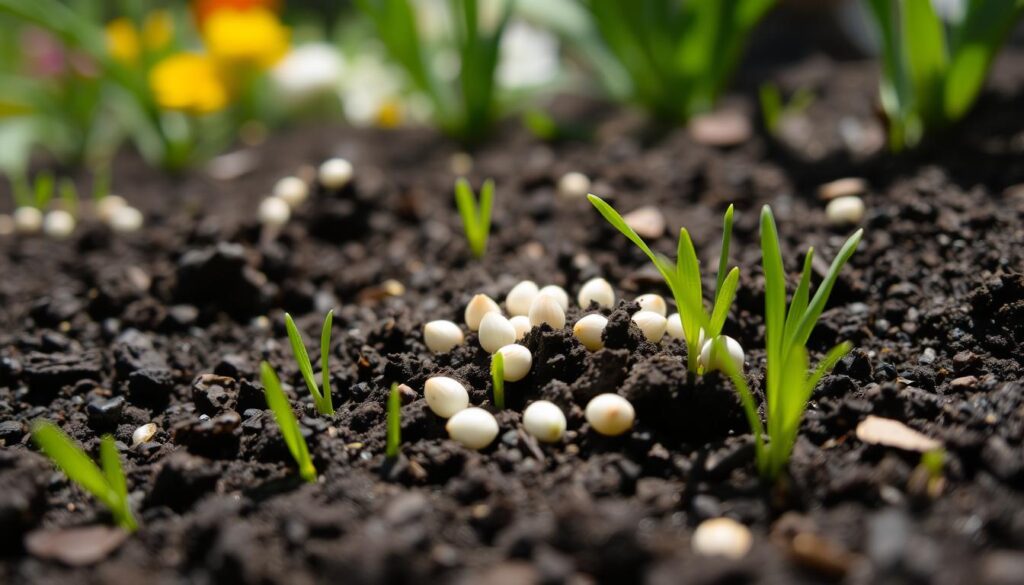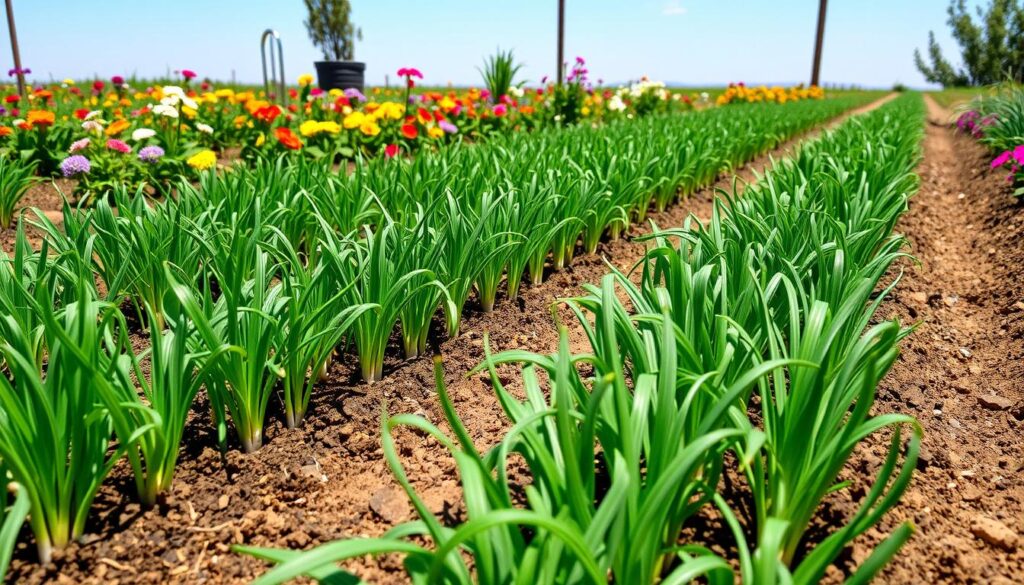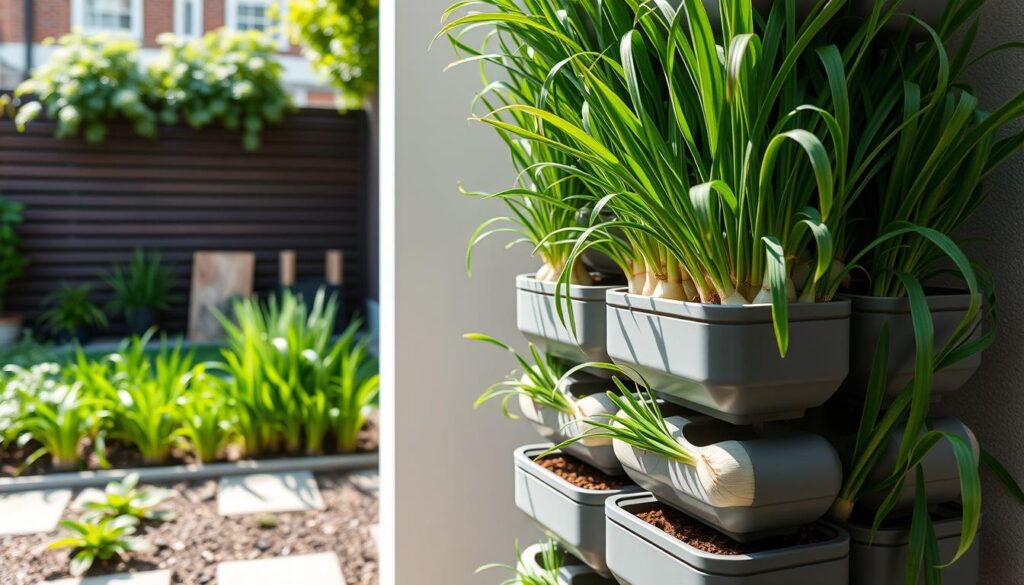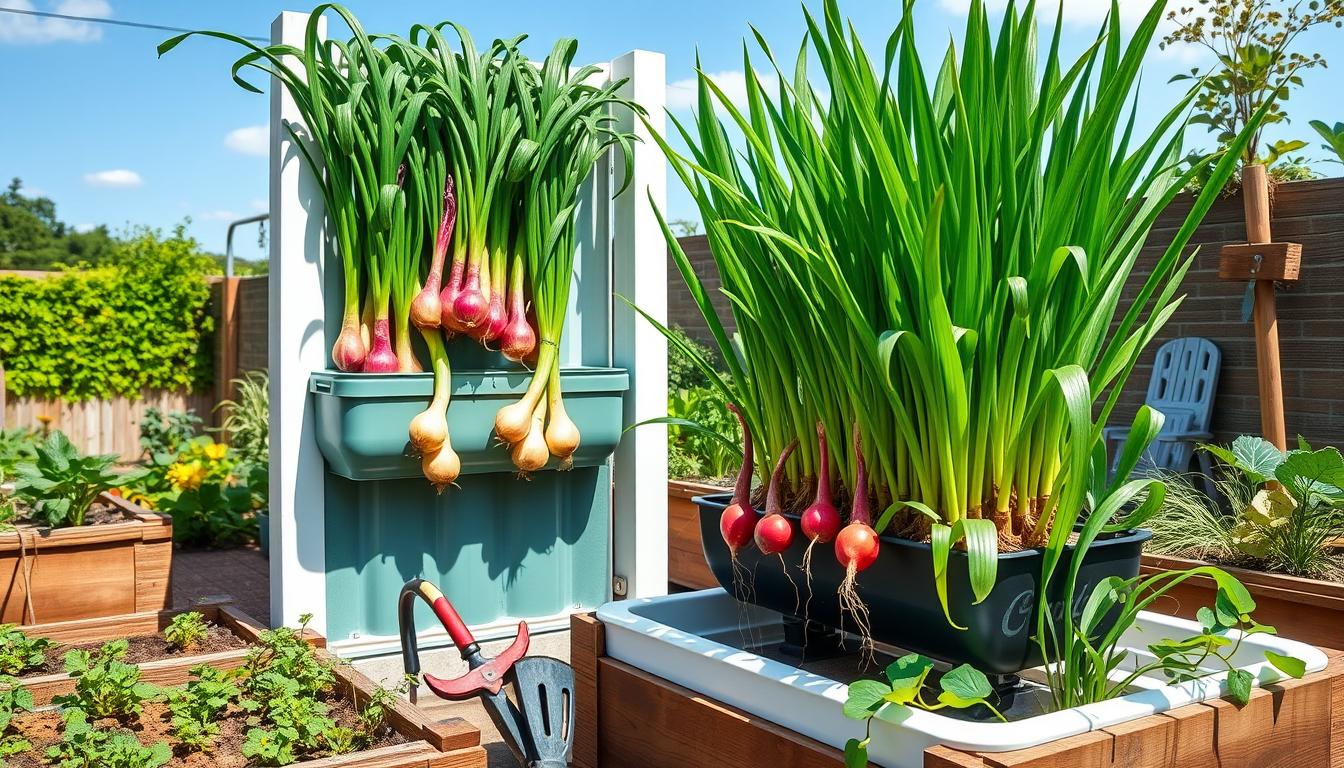Growing our own food is a joy, especially in small spaces. Onions are great for tiny gardens and city plots. With a few smart tricks, we can grow lots of onions and enjoy our homegrown harvests.
Key Takeaways
- Choose the right onion varieties for your climate to ensure successful growth
- Start onions from seed or sets to get a head start on the growing season
- Utilize intensive planting methods and companion planting to maximize space
- Explore vertical gardening and container growing for compact onion cultivation
- Implement succession planting for a continuous supply of fresh onions
Choose the Right Onion Variety
Choosing the right onion variety is key for a great harvest. Onions fall into two main types: short-day and long-day. The choice depends on your garden’s location and climate.
Short-day Onion Varieties for Southern Gardens
In the southern United States, below the 35th parallel, short-day onion varieties are best. Vidalia onions are a popular choice. They start forming bulbs when the day is 10-12 hours long in early spring. They love warmer climates, making them ideal for southern gardeners.
Long-day Onion Varieties for Northern Gardens
For gardeners in the northern states, long-day onion varieties are the way to go. These onions bulb up in the 14-16 hour summer days. They produce great storage onions that last through winter. They’re perfect for northern gardeners who want onions all year.
Gardeners in the middle regions might need day-neutral onion varieties or long-day types that adapt to the upper South’s climate.
Knowing the difference between short-day and long-day onion varieties helps us plant the right ones. This leads to a successful and abundant onion harvest.
Start Onions from Seed or Sets
Gardeners have a choice when growing onions: starting from seed or using onion sets. Each method has its own benefits. The best choice depends on your needs and preferences.
Starting onions from seed is great for growing many types of onions. Seed-started onions store better and are often cheaper for large crops. But, they take longer to grow than those from sets.
Starting onions from sets is quicker and easier, especially for small crops. Sets are small bulbs that can be planted directly in the garden. They’re perfect for beginners or those with little space. While sets offer less variety, they’re reliable and quick to start.
Whether you start with seeds or sets, proper planting and care are key. With the right techniques, you can have a great onion harvest in any small space.

“Growing onions from seed allows for more variety, but using sets is a quicker and easier option for small-scale gardeners.”
Maximize Space with Intensive Planting
Growing onions in small gardens means using every inch of space. Intensive onion planting is a great way to do this. By planting onions 3-4 inches apart, we can grow more onions in less space.
Spacing and Layout for Intensive Onion Planting
Getting the onion spacing right is important for high-density onion crops. Plant onions in rows, 12 inches apart. Then, space each onion 3-4 inches from the next. This way, we can grow more onions in a small area without hurting their growth.
Companion Planting and Intercropping Onions
We can also use onion companion plants and onion intercropping to make the most of our garden. Vegetables like carrots, tomatoes, and leafy greens do well with onions. This is because onions’ scent keeps pests away. By choosing the right plants, we can grow a lot in a small space.
But remember, onions need room to grow. Make sure each onion has enough space. This prevents them from competing with other plants.

“Proper spacing and layout are crucial for achieving high-density onion crops in small-scale gardens.”
Space-Saving Tips for Growing Onions in Small Gardens
Don’t let a small garden stop you from growing onions. There are smart ways to grow lots of onions in little space. These tips will help you make the most of your garden.
Vertical gardening is a great idea. Raised beds and container gardening let you grow onions up, not out. This saves space and lets you grow more onions in a small area.
Succession planting is another smart move. Plant onions at different times to have a steady supply. This way, you get onions all season without using too much space.
- Utilize raised beds and container gardening to grow onions vertically
- Implement succession planting for a steady, space-efficient onion harvest
- Explore companion planting and intercropping to maximize onion yields
“By employing these space-saving strategies, you can grow a bountiful onion crop in even the smallest of gardens.”
With a bit of creativity and planning, you can grow onions in a small space. Try these tips and enjoy fresh onions from your garden.
Vertical Gardening for Compact Onion Cultivation
Vertical gardening is great for growing onions when space is tight. It lets gardeners use every inch of space. This way, even small yards or balconies can grow a lot of onions.
Raised Beds and Container Gardening for Onions
Raised beds and containers are perfect for onions in small spaces. They let you focus the soil, giving onions a deeper root zone. Raised beds also drain well, which onions need to grow healthy.
Start with vertical gardening for onions using raised bed gardening for onions or onion container gardening. These methods help grow onions in tight spots.
| Technique | Benefits for Onion Cultivation |
|---|---|
| Raised Bed Gardening |
|
| Container Gardening |
|

“Vertical gardening is a game-changer for onion growers with limited space. By thinking outside the traditional garden bed, we can cultivate a bountiful onion harvest in the most compact of areas.”
Succession Planting for Continuous Harvests
Gardeners with small spaces can keep onions coming by using succession planting. This method involves planting onions at different times. It ensures a steady flow of fresh onions all season. By planning your plantings, you can have continuous onion harvests without overcrowding your garden.
To start with succession planting onions, follow these tips for small-space onion farming:
- Plan your planting schedule. Make several small sowings of onion seeds or sets every 2-4 weeks, starting in early spring.
- Choose a variety of short-day and long-day onion cultivars to extend the harvest window.
- Utilize compact growing techniques like vertical gardening and raised beds to maximize your small garden design.
- Intercrop onions with other quick-maturing vegetables to make the most of your limited space.
By using smart succession planting strategies, you can have a rich harvest of onions from your small garden all season.

“Succession planting is the secret to a steady supply of fresh produce from a compact garden.”
Onion Varieties for Urban and Small-Space Gardens
Growing onions in small spaces, like urban gardens, requires the right variety. We’ve picked compact, high-yielding onions that do well in tight spots. This way, you can get a big harvest even with little room.
The Stuttgarter onion is a classic German choice. It’s small but packs a big flavor punch. The Red Marble onion has stunning burgundy skin and a sweet taste. For a splash of color, try the Redwing onion, which is bright red and grows well in small gardens.
Day-neutral onions like Candy and Stockton Red also work well in small spaces. They don’t need specific day lengths, making them easy for urban and small-scale gardeners.
| Onion Variety | Characteristics | Ideal for Small Spaces |
|---|---|---|
| Stuttgarter | Compact size, full-flavored bulbs | ✓ |
| Red Marble | Beautiful burgundy skin, sweet and mild taste | ✓ |
| Redwing | Vibrant red color, performs well in small gardens | ✓ |
| Candy | Day-neutral, less dependent on day length | ✓ |
| Stockton Red | Day-neutral, less dependent on day length | ✓ |
Choosing the right onions for your small garden can lead to a great harvest. Try these compact and versatile options to make the most of your space.
Conclusion
Growing onions in small gardens and urban areas needs a smart plan. But the benefits are huge. By picking the right onion types, starting them from seed or sets, and using space-saving methods, we can get lots of onions. Even in tiny outdoor spots.
With some planning and care, we can get the most from our onions. This is true for anyone, whether you have a balcony in the city or a small yard in the suburbs. The tips on small-space vegetable gardening and urban gardening techniques help us use every inch of our garden. This way, we can enjoy the taste of onions we grow ourselves.
By using the tips from this article, we can all grow onions, even with very little space. With a bit of creativity and love for gardening, the options for growing onions in small gardens are endless.
FAQ
Q: What are some space-saving tips for growing onions in small gardens?
A: To save space, use intensive planting and vertical gardening. Try raised beds and container gardening. Succession planting also helps to get more onions from a small area.
Q: How do I choose the right onion variety for my climate?
A: For gardens in the South, choose short-day onions. In northern states, long-day onions work best. If you’re in between, look for day-neutral or long-day onions that do well in the upper South.
Q: Should I start onions from seed or sets?
A: Starting from seed gives you more variety and is cheaper for big crops. Seed-started onions also store better. But, sets are quicker and easier for small crops.
Q: How can I maximize the number of onions I can grow in a small garden?
A: Plant onions closer together, about 3-4 inches apart. This increases the yield per square foot. Planting onions with other veggies also uses space well.
Q: What are some space-saving techniques for growing onions in small gardens?
A: Use intensive planting and vertical gardening. Try raised beds and container gardening. Succession planting also helps to get more onions from a small area.
Q: What are the benefits of vertical gardening for onions?
A: Raised beds and containers focus the growing medium. This creates a deeper root zone for onions. They also improve drainage, which is key for onion health.
Q: How can I extend the onion harvest season in a small garden?
A: Use succession planting. Make multiple sowings or plantings of onions at different times. This ensures a steady supply of fresh onions all season.
Q: What are some good onion varieties for small gardens and urban settings?
A: Choose compact, high-yielding onions like Stuttgarter, Red Marble, and Redwing. They grow full-sized bulbs despite being small. Day-neutral varieties like Candy and Stockton Red also work well in tight spaces.






